Christel McCanless and Annemiek Wintraecken
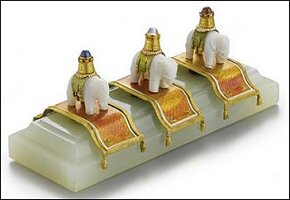
Sotheby’s New York, Russian Art,
April 21, 2010, lot 180
There is no evidence to date that Maria Feodorovna ever purchased a bell push with three elephants. However, Valentin Skurlov, a St. Petersburg archivist of documents pertaining to Fabergé’s business operations, in his list of bell pushes purchased by the Russian Imperial family cites only one decorated with three elephants (likely the same one illustrated above $266,500). An invoice dated December 24, 1898, indicates Tsar Nicholas II purchased an electric bell push with three elephants.
If this is the same item mentioned by the Tiffany Studios artist, Amalia Kϋssner Coudert, in an article (“The Human Side of the Tsar.” The Century Illustrated Monthly Magazine, vol. 72, no. 6, October 1906: 845-5), it is easy to assume Nicholas purchased the bell push as a Christmas gift for his wife.
Coudert, a society miniaturist in New York, painted portraits of the English Royal family in 1896. Three years later she was commissioned to paint the Grand Duchess Maria Pavlovna followed by a second commission, this one of the Empress Alexandra at the Winter Palace. In her reminiscences of the sittings with the Tsarina, Coudert mentions,
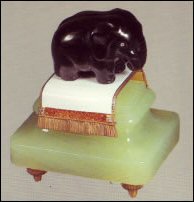
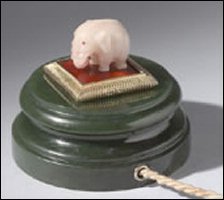
Collection of Queen Margrethe II of Denmark
(Courtesy Wartski)
In addition to the triple bell push sold this spring, the Emperor himself purchased two more bell pushes with elephants on January 23, 1898, for 120 rubles, and another in 1909. Alexandra appears to have purchased only one such piece, on December 24, 1902. The total comes to twelve elephant-motif bell pushes sold by Fabergé to Tsar Nicholas, his wife and his mother between 1898 and 1909. There could be more, but the invoices’ descriptions of the items purchased are often abbreviated to the extreme. Aside from a reference to the purchaser, the inventory number and the price, there is little said about the merchandise itself, except for “electric bell push”. This author is only aware of one sale of an elephant bell push outside of the Imperial family – Edward Tuck, an American bought it in Monte Carlo in 1914 from agents of the Fabergé London shop. Given that the three august imperial personages purchased at least 270 bell pushes from the Fabergé workshop in St. Petersburg between 1891 and 1914, twelve is a very small number with elephant motives, an indication that such pieces were quite rare in Fabergé’s overall production.
Bulldog Missing from the Hermitage Museum Collection
Another in a series of similar Fabergé bulldogs, this one known from pictorial records, was allegedly stolen in 2006 from a Russian museum collection. Please report any whereabouts to Christel McCanless.
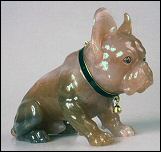
State Hermitage Museum
(Courtesy Géza von Habsburg)
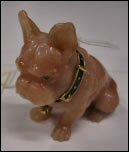
Virginia Museum of
Fine Arts
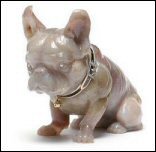
Mango
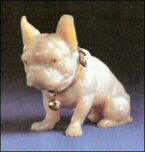
Cody
Geoffrey Munn of Wartski responded quickly to the challenge of identifying extant Fabergé cufflinks given in 1914 as gifts to her teachers by Grand Duchess Olga Nikolaevna (1895-1918), eldest daughter of Tsar Nicholas II and his wife Alexandra Feodorovna. Archival records were recently found in the St. Petersburg Archives for these commissioned pieces.
One set of cufflinks was given to Charles Sydney Gibbes (1876-1963), teacher of English to the Imperial children from October 1908 on. Sold by Gibbes’ grandson to Kenneth Snowman, proprietor of the family business of Wartski in London, they are illustrated in Snowman, Fabergé: Lost and Found (1993), 168. Gibbes adopted a son (George Gibbes), converted to the Russian Orthodox Church, and was eventually ordained as a priest assuming the name of Father Nicholas. He died in Oxford, England.
Also illustrated in Jonas, Susan, and Marilyn Nissenson, Cufflinks (1991), 45. (Courtesy of Jim Hurtt)
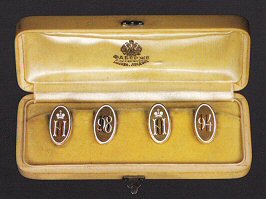
Fabergé Cufflinks
(Courtesy Wartski)
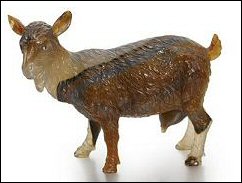
(Courtesy Sotheby’s)
June 7, 2010 Bonhams London
Russian Sale
Silver-mounted seed pearl and enamel clock (below) from the collection of Prince Mikhail Cantacuzène and Julia Grant Cantacuzène.
June 8, 2010 Christie’s London
Russian Art
Sixty Fabergé objects highlighted by 45 objects new to the market from the collection of a European Royal Family. Turkey (below) is from a private collection with an extensive exhibition history from 1980-2000.
June 9, 2010 Sotheby’s London
Russian Works of Art, Fabergé and Icons
Pansy in its original Fabergé case with a note inscribed in ink – Present from Queen Alexandra to 1st Lady Iveagh – is one of 32 objects exhibited ahead of the auction at the Moscow State Historical Museum in May 2010.
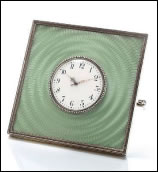
(Courtesy Bonhams)

(Courtesy Christie’s)
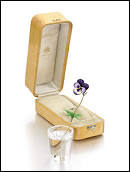
(Courtesy Sotheby’s)
The Collection of Patricia Kluge
Includes a silver centerpiece in the rococo revival style.
June 10, 2010 Uppsala Auktionskammare, Uppsala, Sweden
Russian Sale
Tatiana Muntian, curator of the Moscow Kremlin Museums, led a seminar in April for antique lovers at the auction house during which she illustrated characteristics of Russian jewelers (Fabergé, Tillander, Khlebnikov, etc.) using the objects to be auctioned. (Contributed by Lars Ohlander)
Fauxbergé
Dorothy and Artie McFerrin whose Fabergé collection is on view in Houston, Texas, have generously allowed a fake to be shown with their collection. Rich Hutting, a docent at the museum, shared this happening:
“Mister, why is that egg so drab?” she asked. After complimenting her use of vocabulary, I replied, “because it’s not Fabergé.”
Frog Prototypes
A reader, who enjoys studying auction catalogs, has suggested a bronze statue by the French animal sculptor, Emmanuel Frémiet (1824-1910), is a prototype for two Fabergé objects shown below.
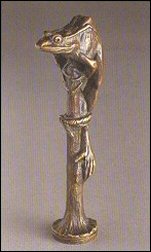
Cacget Grenouille
(Courtesy Eugène Rothschild
Sale, Sotheby’s Paris 11/6/03)
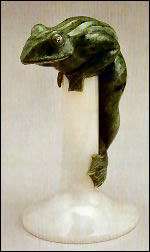
Frog on Stand
(Courtesy The Christian
de Guigné Collection)
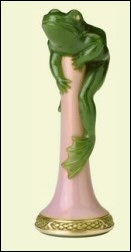
Frog Seal
(Courtesy The Royal
Collection Her Majesty
Queen Elizabeth II)
Opened May 15, 2010 San Diego Natural History Museum, California All That Glitters: The Splendor & Science of Gems and Minerals.
The educational venue includes ten Fabergé hardstone animals on loan from the American Museum of Natural History, New York City. (Courtesy of Tim Adams)
The Alexander Palace is to become a multi-museum and exhibition complex. The Hermitage Pavilion at Tsarskoe Selo restoration is now complete for the 300th anniversary celebration in June 2010. (Courtesy Paul Gilbert, editor of Royal Russia News)
July 18, 2010 Toby Faber Lecture: The Imperial Easter Eggs of Carl Fabergé. Crown Hotel Harrogate, North Yorkshire, UK.
Photograph Identification
(We need your help in completing these photo galleries!)
A photograph of Nicholas II and Alexandra Feodorovna in a wooden frame featured in a previous newsletter initiated a spirited email exchange with some preliminary conclusions between Fabergé enthusiasts in Russia, Finland, the Netherlands, and the United States. Once a year during the Tsar’s reign, the Emporer and his wife posed for official photographs, and later there was a second series which included the children. It was customary to present these official thank-you gifts with inexpensive frames made by a court supplier. For more august events or persons, the photograph was placed in a costly frame made by a jeweler, including Fabergé. As an added token of appreciation, the photographs were autographed by the Imperial pair, sometimes with a date and/or an inscription.
The consensus of the email quartet is that the first official photograph of the married pair was taken early in 1895 not 1894, since there was not much time to travel to St. Petersburg for an official photograph session after Alexandra’s arrival in Livadia (October 10/22, 1894), the death of Tsar Alexander III (October 20, November 1) followed by a period of mourning, and the marriage of the Imperial pair (November 14/26). A framed photograph (now perhaps in the McFerrin Collection) was in 1987 identified as Tsar Nicholas II and Marie Feodorovna (Editor’s note: it is Alexandra Feodorovna) by A. Pasetti, dated 1897 by Fabergé, apparently unmarked. As yet no historical connection of the inscription with the 1897 date has been discovered, however, the date of the photograph is more correctly 1895. Nicholas II wrote in his diary on Friday, May 26, 1895:
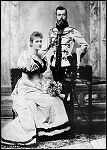
Engagement 1894
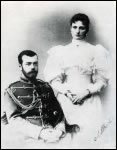
1895
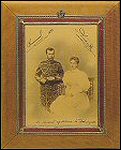
(Courtesy Christie’s)

1896

1897
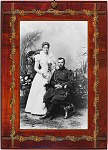
1898 The Erkki J.
Jokinen Collection

1896

1897
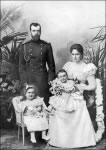
1898
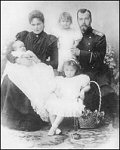
1899

1900

1901
A reader intrigued by the inconsistencies of marks stamped on miniature Fabergé pendant eggs asked for a clarification. Peter Schaffer of A La Vieille Russie shared these general guidelines based on years of experience as a Fabergé dealer in New York City:
The photographs below show an authentic Fabergé miniature egg with marks for Eduard Schramm on the loose jump ring. Kirsch recalls that when he was originally offered the egg, it came with an unusual provenance: The seller told him it had been purchased by a relative at a yard sale in the 1970’s for a mere $5 or so along with another non-Fabergé egg. This egg was later authenticated and mentioned in a lecture by Dr. Géza von Habsburg as an “example of a very unlikely bargain”.
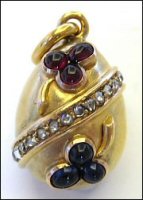
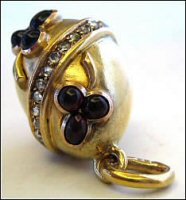
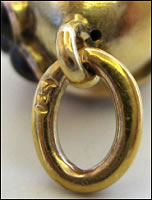
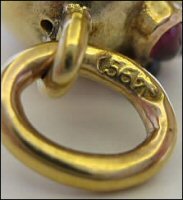
(Courtesy Steve Kirsch)
The author’s chess set collection contains many famous Russian chess sets including two Fabergé chess sets, an amber set created in the workshop of Catherine the Great, etc. The collection was recently exhibited at the Detroit Institute of Art.
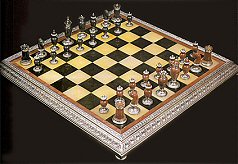
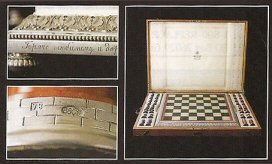
Kuropatkin Chess Set
(Courtesy of Dr. Dean and Art & Antiques, March 2005)
The memoirs of the youngest sister of Tsar Nicholas II of Russia, expanded from a series of interviews she gave at the time of her silver wedding anniversary in 1941. Paul Kulikovsky, editor of Romanov News, and great grandson of the Grand Duchess, fills in the facts behind the reminiscences. (Courtesy Arthur Collingsworth)
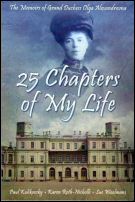
25 Chapters of My Life
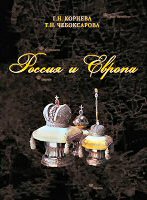
Russia and Europe
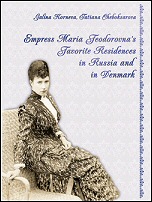
Empress Maria Feodorovna’s
Favorite Residences in Russia
and in Denmark
A second edition of this book depicting the palaces known from the 1890 Danish Palaces egg has been published in English with new materials on the reburial of Maria Feodorovna. The remains of the Empress were moved in 2006 from the Royal Vault of the Cathedral in Roskilde, Denmark, to the Peter and Paul Cathedral in St. Petersburg.
Korneva, Galina and Tatiana Cheboksarova. Россия и Европа (Russia and Europe – Dynastic Relationships in the Second Half of 19th – Beginning of 20th Century) (2010, St. Petersburg, Liki Rossii). In Russian.
The era of Fabergé after the 1900 Paris World Exhibition, designated by the author’s as Faberge’s époque, is illustrated with 500 photographs from leading European and Russian archives. Main events in the life of the Romanovs and their wide circle of relations from European royal houses are depicted with photos of their residences, group photos with full identification, and archival photos of Fabergé customers.
Galina Korneva and Tatiana Cheboksarova have found this note written in English by the Empress in the Russian State Historical Archives (Fund of Chancellery of Empress Alexandra Feodorovna) in St. Petersburg:
“This is a mistake, they must only give 100 Rubles, which makes 200 Marks. Please, keep the 100 Rubles (the other kindly return) and when I get the rest, Fabergé must have it
100 Rubles Pr And Pr-ss Battenberg
200 Rubles Gr D and Gr Duchess of Hesse
300 Rubles Gr D and Gr Duchess Serge
400 Rubles The Emperor and I
1000 Rubles
You must take the 200 rub from my sums and 200 rub from the Emperor’s. We gave Fabergé the 3 sapphires (sic) from the Cabinet for the brooch.”
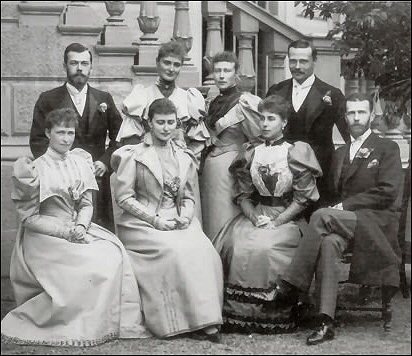
Alexandra Feodorovna (top row, second from left) with her sisters and brother,
1894 in Darmstadt (Photo by Apic/Getty Images)
If you can identify this brooch, please respond to the Editors.
